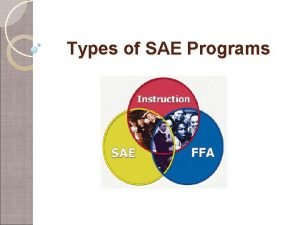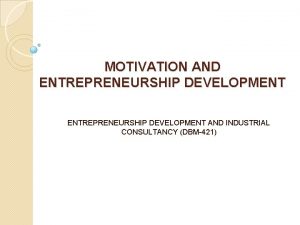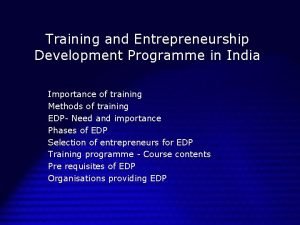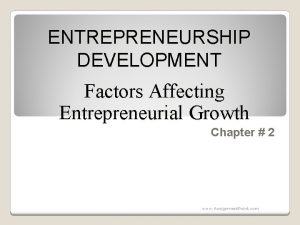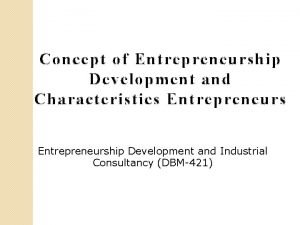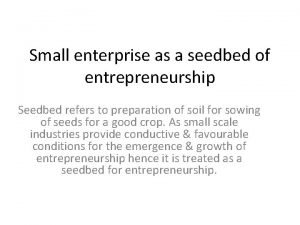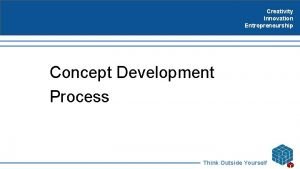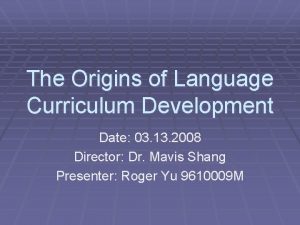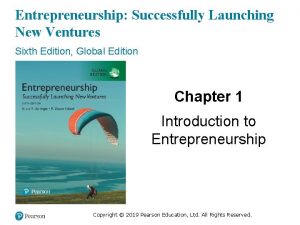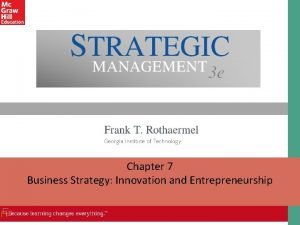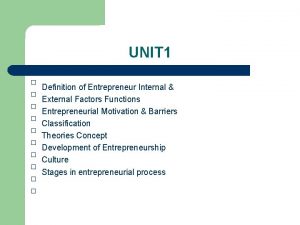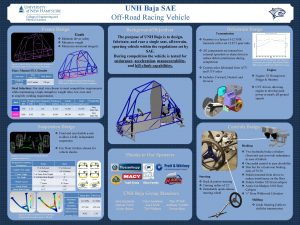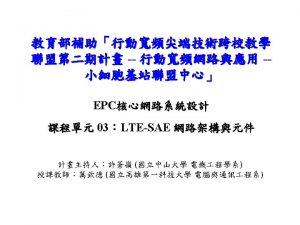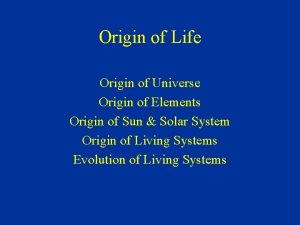Entrepreneurship SAE ORIGIN DEVELOPMENT AND TYPES OF ENTREPRENEURSHIP

























































- Slides: 57

Entrepreneurship SAE

ORIGIN, DEVELOPMENT AND TYPES OF ENTREPRENEURSHIP SAE

INDEX ROLL NO NAME TOPICS 301 NIRMALA • History and Origin. • Stages of evolution of entrepreneurship. 302 NETESH • Entrepreneurs role towards economic growth and development: (i)Innovation (ii)Backward and forward linkages. (iii)Optimum use of resources. 303 SYLVESTER (iv) Regional dispersal of industries. (v) Capital formation 304 NADIA (vi) Improvement in per capita income. (vii) Generation of employment. (viii) Improvement in living standard. (ix) Economic independence. SAE

ROLL NO NAME TOPICS 305 RUQAIYAH (x) Increase productivity. (xi)Reduce unrest and tension. (xii) Manpower or human resources. Theories of entrepreneurship – 1. Economic theory. 306 ALISHA 2. Sociological theory 307 SHRADHA 3. psychological theory 308 MELISHA 4. Integrated theory 309 HADRINA Types of entrepreneurs (i)Based on decision making (ii)Based on gender (iii)Based on location SAE

ROLL NO N AME TOPICS 310 DIONISIO (iv) Based on educational background. (v) Based on market operated. 311 VELONIA (vi) Based on business – Trading, Industrial, corporate entrepreneur and agriculture. 312 XAVIERINA (vii) Other classification (a)Innovation (b)Imitative (c)Fabian 313 TRANIE (Vii) Other classification (d) Drone Ø Individual and Institutional Ø Entrepreneurs by inheritance 315 BASTEN SAE Intrapreneurs Difference between entrepreneur and Intrapreneur

What is an Entrepreneur? • An Entrepreneur (ahn’tra pra nur) is a person who organizes and manages a business undertaking, assuming the risk for the sake of profit. Any person (any age) who starts and operates a business is an entrepreneur. SAE

Who is an entrepreneur? • One who owns and operates a business venture. • One who accepts all the risk. • One who tries to identify and meet a need for a product or service. • Examples …………. SAE

1930, Harland sanders • Opened sanders court and café in the front Room of a gas station. • Awarded the first Franchise to Pete Harman in salt Lak city, Utah. SAE

Bill Gates , 1955 • By linking his microsoft Software to IBM’s first PC’s , he dominated the industry. SAE

Ashutosh Gupta, 19 v. Owner of Gupta financial consulting. v. Has clients with revenue Between $200, 000 & $3. 3 million. SAE

History & Origin • Entrepreneurial history of any country is based on economic history. India. • Organized industrial activity: Banaras, Allahabad and Mizapur. • Handicraft industry decline due to industrial revolution in England SAE

STAGE IN EVOLUTION OF ENTREPRENEURSHIP 1) ANCIENT PERIOD: • Before industrial revolution • It was developed nation • India was called golden bird. SAE

• a) DEVELOPMENT STAGE 1857 -1947 • East India company contributed growth of entrepreneurship India adopted policies of discrimination protection. • Lost of monopoly by east India company. SAE

• b) DEVELOPMENT AFTER INDEPENDENCE (1947 ONWARDS) • Objectives: • *Proper distribution of economic power. • *Encourage the growth of industries • *encouragement of small-scale industries. SAE

Entrepreneur’s role towards economic growth and development: • The one major issue we address here is: What is the significance of entrepreneurship for economic development? Dose it add an important independent influence to that of other factors widely agreed to promote economic development? SAE

• Adam Smith, the foremost classical economist assigned no significance to entrepreneurial role in economic development in his monumental work. • David Ricardo identified only three factors of production, namely, Machinery, Capital, and Labour, among whom the entire produce is distributed as rent, profit and wages respectively SAE

1. Innovation • Schumpeter visualized the entrepreneurs as the key figure in economic development. • The entrepreneur searches for change, sees need and then brings together the manpower, material and capital required to respond the opportunity what he sees. SAE

2. Backward and forward linkages • An entrepreneur initiates changes which has a chain reaction. • E. g. . the establishment of a steel plant generates several oxcillary units and expands the demands for iron ore , coal etc. SAE

3. Optimum use of resources • It is the responsibility of the entrepreneur to make use of resources at the fullest extent. • The resources include land , money , labour, machinery. SAE

4. Regional dispersal of industries / Balance regional development • India itself is an under-developed country aims at decentralized industrial structure to militate the regional imbalanced in levels of economic development. • Small-scale entrepreneurship in such industrial structure plays an important role to achieve balanced regional development. SAE

5. Capital Formation • Entrepreneur mobilizes the idle savings. • Saving in industry result in productive utilization of national resources. • An entrepreneur is the creator of wealth. SAE

6. Improvement in per capita income • Entrepreneurs locate and exploit opportunities. • It convert idle resources like road, labour and capital into national income and wealth in the form of goods and services. SAE

7. GENERATION OF EMPLOYMENT. • Entrepreneurs generate employment both directly and indirectly. • Entrepreneurship helps to reduce the unemployment problem in the country. SAE

8. IMPROVEMENTS IN LIVING STANDARDS • Entrepreneurs set up industries which remove scarcity of essential commodities and introduce new products. • Production of goods on mass scale helps to improve the standard of living of a common man. SAE

9. Economic independence • Entrepreneurship is essential for national self – reliance. • Businessman exports goods and services on a large scale and earns foreign exchange for the country. SAE

10. Increases productivity • The entrepreneur through massive small scale and large scale industries , it helps in growing productivity in the enterprise. • The entrepreneur plays a vital role through good relation. SAE

11. Reduces unrest and tension • An entrepreneur plays a crucial role in solving tensions and problems and tries to minimize it. SAE

12. Manpower or human resources • Manpower or human resource means the quantity as well as the quality of population. • High productivity and efficiency would depend on their skill enterprise knowledge, imagination and good health. SAE

THEORIES OF ENTREPRENEURSHIP • The concept of entrepreneurship and its theory have been evolved over a period of more than two centuries. There are different opinions on the emergence of entrepreneurship. These opinion may be classified into 3 categories, they are: (1) Economic theory, (2) sociological theory, (3) psychological theory (4) integrated theory. SAE

1. Economic theory • G. F. Papanek and J. R. Harris, are the main developers of this theory. • The economic incentives includes taxation policy, industrial policy of the government, demand supply, market position. • In economic theory cost, incentives and gains are the important elements considered for the emergence of entrepreneurship. SAE

• According to Marshall, organization and are the major functions of an entrepreneur. • According to Tandan, the entrepreneur must possess: a) Ability of organization and administration, b) Ability of material resources, c) Technological knowledge, willingness to accept changes, ability to initiate, opportunity, d) Capacity to assume risk and self confidence. SAE

2. Sociological theory • According to sociologist entrepreneurship is most likely to emerge under a specific social culture. • According to Weber, Religion beliefs produce intensive exertion in occupational pursuits. SAE

• According to Frank Young, is mainly concerned with inter group relations and his theory of change is based on society’s incorporation of reactive group. • According to Schumpeter, an important factor in terms of social climate which influence the behavior of the of an entrepreneur for the emergence of entrepreneurship. SAE

3. Psychological theory Ø According to the psychological entrepreneurship is most likely to emerge when a society has sufficient supply of individuals possessing particular psychological characteristics. ØSchumpeter believes that entrepreneur is motivated by will to power will to find a private kingdom or will to conquer. SAE

Ø Hagen’s consider withdrawal of status respect as a trigger mechanism for change in personality formation. Ø According to Mc Clelland , the need for achievement is one of the drives toward entrepreneurial growth. SAE

4. Integrated theory Ø Each of the above theory is incomplete and none of them is right or wrong. Ø Entrepreneur is influenced by a multiple factors and therefore no single factor whether economic, social or psychological generates entrepreneurship. Ø The economic, political and legal factor if positive to the entrepreneur can be quickly generates and make environment favorable to the emergence of entrepreneurship. SAE

Types of entrepreneurs SAE

1. Based on decision-making –Forced Entrepreneurs • Neo-rich Indians returning from aboard (NRIs) and educated unemployed seeking selfemployment may be described as forced entrepreneurs. • Entrepreneurs may also be classified into first generation (new) and established entrepreneurs, rural and urban entrepreneurs, male (men) and female (women) entrepreneurs, small-scale and large-scale entrepreneurs, etc. SAE

2. Based on Gender -Men and Women Entrepreneurs • From the olden days man is supposed to organize for everything, i. e. , work to get money, protect the family. • The advantages of man entrepreneur is that he can run about from place-to-place to secure orders for his business, arrange for bank finance etc. SAE

3. Based on location – Rural, Semi urban and Urban • Urban entrepreneurs are those who work in the city areas. • The rural entrepreneur is one who comes from the rural areas. SAE

4. Based on educational background -Based on educational background • An educated entrepreneur is one who has received the basic education at least. i. e. , he can read and write. • There are two types of education, one formal education and the other specialized education. SAE

5. Based on market operated. Local/Indian/Foreign entrepreneur • The local entrepreneurs are able to have better understanding of the nature of the products demanded. • An Indian entrepreneur carries on the business of his forefathers in the similar ways as was done years back. SAE

6. Based on Business – Trading, Industrial, Agricultural and Corporate Entrepreneur a) Trading entrepreneur: Trading entrepreneur is one who undertakes trading activities and is not concerned with manufacturing work. SAE

b) Industrial Entrepreneur: ü He is a product- oriented man. ü The entrepreneur has the ability to convert economic resources. Lakshmi mittal --SAE

c) Corporate Entrepreneur • Corporate entrepreneur is a person who demonstrates his innovation skill in organizing and managing corporate undertaking. SAE

d) Agricultural Entrepreneur: • Agricultural Entrepreneur is that entrepreneur who undertakes agricultural activities as raising and marketing of crops, fertilizer and other inputs of agriculture. SAE

7. Other classification – ( i) Innovation (ii) Imitative (iii) Fabian (iv) Drone (v) Individual and Institutional (vi) Entrepreneurs by Inheritance. SAE

(i) Innovation entrepreneurs • Innovation entrepreneurs are generally aggressive in experimentation and cleverly put attractive possibilities into practice. • Innovating entrepreneurs are very commonly found in developed countries. SAE

(ii) Adoptive or imitative entrepreneurs • This kind of entrepreneurs is ready to adopt successful innovation created innovative entrepreneurs. • Such entrepreneur are particularly important in underdeveloped countries. SAE

(iii) Fabian entrepreneur • Entrepreneurs of this type are very cautions and skeptical while practicing any change. • They are not much interested in taking risk and they try to follow footsteps of their predecessors. SAE

(iv) Drone entrepreneur: • Drone entrepreneurship is characteristic by a refusal to adopt and use opportunities to make changes in production. • Such entrepreneurs may even suffer losses but they do not make changes in production methods. SAE

• (a) Individual and Institutional entrepreneurs: • In the small scale sector individual entrepreneurs are dominant. • Individual entrepreneur and institutional entrepreneur coexist and support each other. SAE

• (b) Entrepreneur by inheritance: • People become entrepreneurs when they inherit the family business. SAE

Intrapreneurs: • The term ‘Intrapreneur’ was coined in America in the late seventies. • Intrapreneurs introduce new products services and processes which enables to company to grow and succeed in a changing environment. • Such people are ‘Intra-corporate entrepreneurs’ or Intrapreneurs’. SAE

Difference between Entrepreneur and Intrapreneur Difference Entrepreneur Intrapreneur (1) Dependency An entrepreneur is an Whereas, an Intrapreneur independent businessman is semi-independent businessman. (2) Risk An entrepreneur bears full risk involved in the business An Intrapreneur does not fully bear the risk of the business he develops and operates. (3) Operation An entrepreneur operates from outside an organization On the contrary, an Intrapreneur operates from within the organization itself. (4) Raising of capital The entrepreneur himself On the other hand, the SAE raises the recovery capital Intrapreneur does not from various sources. raise the capital himself.

(5) Guarantee of returns Guarantees the return to Does not guarantees any (6) Characteristics people who give him finance. return to the suppliers of capital. Whereas, the Intrapreneur is The entrepreneur is a a creator or inventor. innovator SAE

THANK YOU SAE
 Entrepreneur and intrapreneur
Entrepreneur and intrapreneur Research sae examples
Research sae examples Ownership/entrepreneurship sae examples
Ownership/entrepreneurship sae examples Entrepreneurship sae examples
Entrepreneurship sae examples Entrepreneurship module 1 introduction to entrepreneurship
Entrepreneurship module 1 introduction to entrepreneurship Types of sae
Types of sae Motivation and entrepreneurship development
Motivation and entrepreneurship development Importance of entrepreneurship development programme
Importance of entrepreneurship development programme Global entrepreneurship and development index
Global entrepreneurship and development index Entrepreneurship and regional development
Entrepreneurship and regional development Historical perspective of community development
Historical perspective of community development What is types of industrial estates?
What is types of industrial estates? Functions of industrial estate
Functions of industrial estate Ssib in entrepreneurship
Ssib in entrepreneurship Ten deadly mistakes of entrepreneurship
Ten deadly mistakes of entrepreneurship Psychological factors affecting entrepreneurial growth
Psychological factors affecting entrepreneurial growth Concepts of entrepreneurship development
Concepts of entrepreneurship development Small business as a seedbed of entrepreneurship
Small business as a seedbed of entrepreneurship Concept development in entrepreneurship
Concept development in entrepreneurship Entrepreneurship development
Entrepreneurship development History of curriculum
History of curriculum Types of corporate entrepreneurship
Types of corporate entrepreneurship Types of corporate entrepreneurship
Types of corporate entrepreneurship Types of innovation in entrepreneurship
Types of innovation in entrepreneurship Types of rural entrepreneurship
Types of rural entrepreneurship External factors of entrepreneurship
External factors of entrepreneurship Steering rack mini baja
Steering rack mini baja Sae baja rack and pinon
Sae baja rack and pinon Rack and pinion gear sae baja cockpit
Rack and pinion gear sae baja cockpit Blue and gold basics sae programs
Blue and gold basics sae programs Knee joint muscles origin insertion
Knee joint muscles origin insertion Serratus anterior muscle
Serratus anterior muscle Supervised agricultural experience ideas
Supervised agricultural experience ideas Unh sae
Unh sae Sae techzone
Sae techzone Sae epc
Sae epc Sae j2579
Sae j2579 Sae technical paper
Sae technical paper Sae reconciliation steps
Sae reconciliation steps Sae j3061 consulting
Sae j3061 consulting Cv sae
Cv sae Sae j 3061
Sae j 3061 Sae j 2464
Sae j 2464 Arp 4761 ssa
Arp 4761 ssa Exploratory sae definition
Exploratory sae definition Sae j1113 4
Sae j1113 4 All obdii vehicles use what type of read-only memory?
All obdii vehicles use what type of read-only memory? Lse sae
Lse sae Sae s-18
Sae s-18 Formula sae
Formula sae Fsae michigan 2018 results
Fsae michigan 2018 results Fsae lincoln 2019 results
Fsae lincoln 2019 results Sae j3068
Sae j3068 Formula sae international
Formula sae international Excavator control levers
Excavator control levers Technician a says that a hoist can be stopped
Technician a says that a hoist can be stopped Michael niehoff
Michael niehoff Essnet sae
Essnet sae





